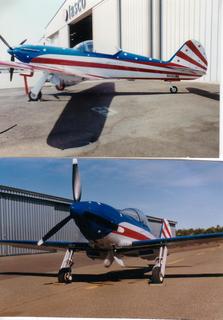 Note, however, the Rodeck block & heads (pictured above) are of the older Chevy 350 design and NOT the same as the LS-1. This is especially noticable with the two center exhaust ports being next to each other. The LS-1 has the two center exhaust ports eaqually spaced. The LS-1 is a complete re-design of the old Chevy 350. The biggest change (other than using Aluminum for the block & heads) is the redesigned heads which are significantly more efficient developing significan amounts of horespower & torque over the old traditional Chevy 350 design. I also like the LS-1 exhaust port spacing better than the older 350 heads. There were many other redesign features of the LS-1 over the old Chevy 350, but overall, the Head & intake manifold redesign & metalurgical technology change was the most significant, IMHO!
Note, however, the Rodeck block & heads (pictured above) are of the older Chevy 350 design and NOT the same as the LS-1. This is especially noticable with the two center exhaust ports being next to each other. The LS-1 has the two center exhaust ports eaqually spaced. The LS-1 is a complete re-design of the old Chevy 350. The biggest change (other than using Aluminum for the block & heads) is the redesigned heads which are significantly more efficient developing significan amounts of horespower & torque over the old traditional Chevy 350 design. I also like the LS-1 exhaust port spacing better than the older 350 heads. There were many other redesign features of the LS-1 over the old Chevy 350, but overall, the Head & intake manifold redesign & metalurgical technology change was the most significant, IMHO! Look closely at the firewall, and you can see part of the Vortec Supercharger installation blowing into the Airflow Performance Fuel injection throttle body. The LS-1 conversion will definitely outperform this Rodeck installation! An LS-2 or LS-6 or especially a C-5(Corvette) conversion would also significantly outperform the LS-1 installation... However, most of the performance increases of these others would only be totally realized if the engines were able to reach their maximum RPM. Unfortunately, the propeller of this aeroplane would only be capable of spinning at a maximum of 2800RPM (about 5000RPM at the crankshaft) and so therefore the amount of performance increase for the amount of money spent would not be very practical. Besides, to have your engine spinning at a constant 6000-7000 RPM would not be a very good thing from the "wear" point of view. Please note that when you are cruising on the freeway at 75-80mph, your engine is only turning around 2000-2500 RPM! Most all aeroplane engines tend to "cruise" at the 75%RPM point, or in the case of this LS-1 would be approximately 3500-3800RPM. This RPM range is reasonable for an automotive conversion engine, and what we really need is really good "Torque" as opposed to purely Horsepower rating(s).
Torque is what is really usable for spinning propellers, not Horsepower. My LS-1 has a custom CompCams.com camshaft and is also degreed such that the maximum torque value occurs at a point just above the "cruise" RPM range. This way, when I need more "umph" it is just a small/short push away on the throttle. If my estimations are correct, I should be getting around 425ft-lbs of torque and about 375hp coming out of my LS-1. We'll see (eventually!)...?





0 Comments:
Post a Comment
<< Home